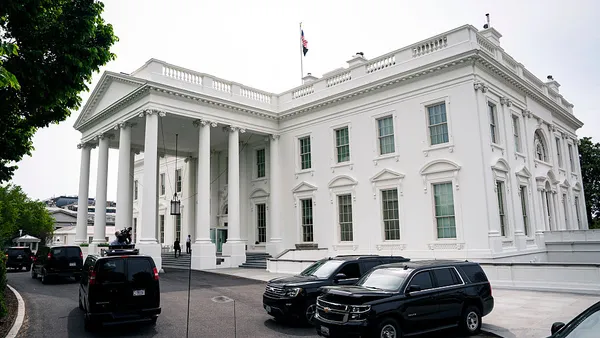Dive Brief:
- The Trump administration is encouraging states and districts to expand school choice options by using already existing avenues under the Elementary and Secondary Education Act, including Title I funds earmarked for low-income school populations.
- In a March 31 letter to chief state school officers, the U.S. Education Department flagged flexibilities currently available under ESEA Section 1003A and Title I, Part A that could be used to help parents choose such things as advanced coursework and career and technical education courses not available at the student's school.
- The guidance follows President Donald Trump's January executive order calling for the Education Department to develop policies giving parents more choice in their children's education. Public school supporters, however, are concerned that diverting any taxpayer-supported K-12 money could hurt public schools.
Dive Insight:
“Today’s guidance is an important early action aimed at advancing educational choice and encouraging states and schools to maximize learning options that help students excel,” said U.S. Education Secretary Linda McMahon, in a statement.
The guidance explains two ways states can provide parents with more education flexibility:
- Direct student services. Section 1003A of ESEA lets states reserve 3% of their Title I allocation for school districts to provide direct student services. The funding could allow parents to have options for their children, such as participation in advanced courses and credit recovery courses. Other activities such as tutoring and dual enrollment could also be funded.
Districts that opt for these funds must explain how they would select providers for these services. Providers do not become federal grantees because districts retain responsibility for the funds. Providers could be colleges, private schools and community organizations.
Only one state — Ohio — is currently using this flexibility, which is focused on bolstering access to advanced courses, said the letter, which was signed by Hayley Sanon, principal deputy assistant secretary and acting assistant secretary in the Office of Elementary and Secondary Education.
Direct student services funds must be targeted to geographically diverse districts that serve high numbers of schools identified for support and improvement. - School academic improvement. This Title I, Part A flexibility allows districts and schools, in consultation with parents, to identify activities that would boost a school's academic improvement, particularly for the lowest performing students. A school, for example, could identify various academic programs and supports for students. A district could also use this Title I allocation to target funding to support students who are homeless.
About 63% of traditional public schools and 62% of public charter schools were Title I-eligible during the 2021-22 school year, according to the National Center for Education Statistics. Title I funding is one of the Education Department's largest allocations, totaling $17.3 billion in fiscal year 2022 across all states and the District of Columbia.
The Education Department said an FAQ on using these flexibilities would be forthcoming, along with additional guidance on expanding school choice.








 Dive Awards
Dive Awards






